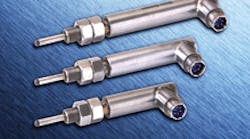Authored by: Robert Repas, Associate Editor, [email protected] |
Here are some of the most recent examples of how sensor technology brings efficiency and safety to new application areas.
Right-angle LVDTs take less space
Here’s one way to shorten a linear-variable-differential transformer (LVDT): Put the connector on the side instead of on the end. That’s the idea behind new LVDTs from Macro Sensors in Pennsauken, N. J. The company offers what it calls a right-angle configuration for its spring-loaded and through-bore LVDT position sensors. Besides making the LVDT shorter, the right-angle connection stops debris from accumulating inside the sensor body. Moreover, the bending radius of the mating cable does not add to the length when there’s a side connection. As a result, the installed length of the LVDT position sensors is at least 2 in. shorter than comparable units with an axially mounted connector.
Another advantage of this configuration: When open at both ends, it’s easy to clean dirt, grit, and dust out of the LVDT.
The sensors are rated to operate up to 220°F (105°C). Hermetically sealed versions, constructed entirely of stainless steel with coil windings sealed against hostile environments to IEC standard IP-68, can withstand pressures up to 1,000 psi. The LVDTs come in both ac and dc configurations. Dc-operated units use built-in electronics to provide such features as frictionless operation and dynamic response, with the added convenience and simplicity of dc input and precalibrated dc output.
Targeted applications include hostile environments containing caustic/corrosive materials or with extreme temperature variations. Many such LVDTs can be found providing displacement measurement in applications for automotive factories, forges and foundries, metal-fabricating machinery, paper and plastic-film plants, sawmills, process-automation applications, hydraulic cylinder, and all types of motion-control systems.
Extended temperature range for point-of-load converters The answer to these problems is the point-of-load (POL) converter. POLs typically step-down a high voltage, such as 5 Vdc, to a lower one and sit near the low-voltage load, thus eliminating the problem of voltage drop along a trace. They also supply a constant voltage regardless of current demand. They typically perform this conversion with efficiencies greater than 90% using digital switching techniques at extremely high frequencies, some in the megahertz range. One such POL is the MFP Series point-of-load converters by Interpoint of Crane Aerospace & Electronics in Redmond, Wash. Designed to produce stable power across a temperature range of –70 to 150°C with a cold start rating of –90°C, the MFP Series is said to deliver low-noise performance without the need of external capacitors. At efficiencies up to 92%, the MFP Series supplies 16 W of power at four preset output voltages of 0.8, 1.6, 2.5, and 3.3 V. Other features include an ability to sync the converter to the frequency of the system or to other MFPs, an output current monitor, output remote sense, output short-circuit protection, and input inrush-current limiting. With an input voltage range of 3.0 to 6.0 V, the converter can handle up to a 15-V transient for a full second in addition to full input overvoltage protection. |
Automotive tires inflated to the wrong pressure don’t last long and may fail prematurely. The same can be said for aircraft tires, as reported by the National Transportation Safety Board (NTSB) in a recently released report of an airliner accident.
NTSB Aircraft Accident Report AAR-10/02 outlines how a Learjet overran the runway during a rejected takeoff at Columbia Metropolitan Airport, in Columbia, S. C. The captain, the first officer, and two passengers were killed while two other passengers were seriously injured. The NTSB says a contribution to the accident was multiple tire failures during the takeoff roll caused by severe underinflation.
Surprisingly, there’s no requirement for aircraft of this type to have a tire-inflation reporting system. Mechanics read the pressure of each tire individually with a gage. On larger aircraft, this can take over an hour, as many times the tire stem is inaccessible, necessitating a change in aircraft position to bring the stem within reach.
In response, Crane Aerospace & Electronics in Lynnwood, Wash., developed the SmartStem system to provide fast and reliable wireless tire-pressure measurement. SmartStem technology replaces the existing tire-inflation valve stem with a special wireless tire-pressure-sensor valve stem that communicates tire pressure, temperature, and other stored information to a control unit onboard the aircraft or to a handheld reader. The newest handheld reader features an integrated display and tire data-management software used for analyzing the recorded information.
SmartStem technology is flight proven on the Boeing 777 and there is a version developed as part of the brake control and monitoring system for the Boeing 787 Dreamliner. The technology is also certified on a variety of Cessna Aircraft Co. business jets including the Sovereign and Citation X aircraft. Future applications include many large commercial, regional and military aircraft models.
New uses for dc electric motors with Hall-effect sensors Increasingly, motor makers are offering to customize their products with special sensor configurations and with other changes aimed at producing a more-targeted end product. Examples include motors equipped with blowers, water pressure or water-circulation pumps, as well as a vast array of switches, relays, sensors, and other related components. |
